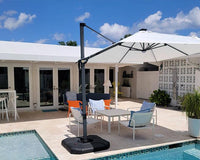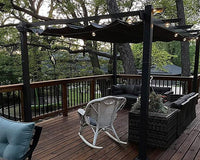Introduction:Why You Need to Anchor Your Gazebo
A gazebo can be a fantastic addition to any backyard, offering shade and a defined outdoor living space. However, these structures, with their large canopies and relatively light frames, can be very susceptible to wind. A sudden storm or even a strong breeze can lift, shift, or severely damage an unanchored gazebo. Taking the time to secure it properly is key to its longevity and your peace of mind.
Why Anchoring Your Gazebo is Non-Negotiable
It might be inconvenient, but skipping the anchoring procedure is asking for trouble. A non-anchored gazebo is actually just a giant kite waiting for the ideal gust of wind.
The most obvious reason is to prevent the damage of the gazebo itself. Wind will buckle frames, rip canopies, and send the whole structure crashing into fences, your house, or your neighbor's lawn.
Safety is another huge concern. A collapsed or airborne gazebo will hurt anyone who happens to be within reach. It can also damage other property, requiring costly repairs or liability. Proper anchoring holds your gazebo firmly in position, protecting people and property.
Finally, a well-anchored gazebo will simply last longer and look better. Consistent movement and stress by wind can lead to weak joints and cause parts to degrade prematurely. Sufficient anchoring reduces this wear and tear.
Assess Your Gazebo and Surface Type
Before you start anchoring, you need to consider two main things: the type of gazebo you have and the surface you're placing it on.
- Gazebo Type: Is it a lightweight, pop-up canopy style, or a more permanent structure with a metal or wooden frame? Lighter gazebos will require more diligent anchoring or temporary weighting solutions. Heavier, more permanent structures often have pre-drilled holes in their legs or base plates specifically for anchoring.
- Surface Type: This is crucial as it dictates the best anchoring methods. Are you setting it up on a concrete patio, a wooden deck, grass, or bare soil? Each surface requires a different approach.

Anchoring Techniques for Different Surfaces
Let's get into the practical methods for securing your gazebo based on where it's located.
On Concrete Patios or Pavers:
This is a common scenario. The best permanent solution here is to use concrete anchor bolts (like wedge anchors or sleeve anchors). You'll need to drill holes into the concrete at the location of each gazebo leg, insert the anchors, and then bolt the gazebo legs or base plates down. This provides a very strong and secure hold. Ensure you use bolts appropriate for the thickness of your concrete.
For a less permanent but still effective option on concrete, especially for lighter gazebos or if drilling isn't feasible, you can use heavy-duty weight bags filled with sand or gravel, placed over each leg or a connecting frame. Some gazebos also come with base plates that can accommodate concrete blocks or purpose-made weights.
On Wooden Decks:
Mounting a gazebo on a wooden deck means securing it to the deck's structural members, not just to the surface boards. Use lag screws or large wood screws with enough length to go through the base of the gazebo leg and gain a firm bite into the deck joists or blocking beneath. Pilot holes may be pre-drilled to prevent splitting the wood. Putting washers under the screw heads spreads the load. Never just screw into the deck boards alone as they aren't strong enough.

On Grass or Soil:
For soft ground like grass or soil, spiral stakes or ground augers are ideal. These are metal stakes shaped like a corkscrew, which you screw into the ground deep. You then attach the gazebo legs to them using ropes, ratchet straps, or bolt the legs onto the stakes if the stakes have appropriate fittings. The deeper the auger, the tighter the grip.
Another option for soil is to use concrete footings. This is more permanent. You dig holes at each leg position, fill them with concrete, and then either set anchor bolts into the wet concrete (to which the gazebo legs are later bolted) or embed the gazebo legs directly into the concrete if the design allows.
Using Weights: A Versatile (Often Temporary) Solution
For situations where drilling or staking isn't possible or desired (like temporary setups, or on surfaces you don't want to damage), weights are your go-to.
- Sandbags or Weight Bags: These are purpose-made bags that you fill with sand, gravel, or even water. They can be strapped or placed directly onto the gazebo legs or frame. Ensure they are heavy enough for your gazebo size and expected wind conditions.
- Concrete Blocks or Buckets: Buckets filled with concrete, sand, or water can also serve as effective weights. Some people even use decorative planters filled with heavy materials.
- Purpose-Made Gazebo Weights: You can buy weights designed to clip or fit onto gazebo legs. These often have a more streamlined look.
While weights are convenient, remember that for very strong winds, they might not be as secure as permanent anchoring methods like bolting or deep staking. Understanding your gazebo's wind tolerance limits will help you determine if weights alone are sufficient for your local weather patterns.
The Importance of Guy Ropes or Straps
In addition to anchoring the legs, especially for taller or lighter gazebos, using guy ropes or ratchet straps can significantly increase stability. Attach these from the upper corners of the gazebo frame and run them outwards at an angle to stakes in the ground or other secure points (like a sturdy fence post, but be mindful of the stress on the fence). This helps to counteract the lifting and swaying forces of the wind on the canopy.
Regular Checks and Maintenance
Anchoring isn't a one-time "set it and forget it" task.
- Periodically check your anchors: Make sure bolts haven't loosened, stakes haven't pulled up, and weights haven't shifted.
- Inspect ropes and straps: Look for any signs of fraying or wear, and replace them if necessary.
- Consider the Weather Forecast: If very strong winds or severe storms are predicted, it's often wise to take down the canopy of your gazebo, or even dismantle temporary gazebos entirely, even if they are anchored. No anchoring system is completely foolproof against extreme weather.
A Note on Canopy Management
The canopy is what catches most of the wind. In addition to anchoring the frame, ensure your canopy is properly tensioned and securely attached to the frame as per the manufacturer's instructions. A loose, flapping canopy can put extra stress on the frame and anchors. As mentioned, removing the canopy before severe weather is often the best way to protect your gazebo.

Protect Your Investment: Final Thoughts on Gazebo Anchoring
Your gazebo is an investment in your outdoor enjoyment, and properly anchoring it is an investment in its safety and longevity. By assessing your specific gazebo, the surface it's on, and choosing the appropriate anchoring methods – whether it's bolts, stakes, weights, or a combination – you can significantly reduce the risk of wind damage. Don't wait for a windy day to find out your gazebo isn't secure; take these steps now.





1 comment
John
What size bolts can the 12×14 aluminum frame accommodate. 1/4, 3/8, 1/2 inch?